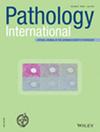腮腺低分化癌伴有尖细胞癌样特征,CRTC3::IQGAP1融合。
IF 2.5
4区 医学
Q2 PATHOLOGY
引用次数: 0
摘要
本文章由计算机程序翻译,如有差异,请以英文原文为准。
Regarding to low-grade carcinoma with acinic cell carcinoma-like features of the parotid gland with CRTC3::IQGAP1 fusion.
求助全文
通过发布文献求助,成功后即可免费获取论文全文。
去求助
来源期刊

Pathology International
医学-病理学
CiteScore
4.50
自引率
4.50%
发文量
102
审稿时长
12 months
期刊介绍:
Pathology International is the official English journal of the Japanese Society of Pathology, publishing articles of excellence in human and experimental pathology. The Journal focuses on the morphological study of the disease process and/or mechanisms. For human pathology, morphological investigation receives priority but manuscripts describing the result of any ancillary methods (cellular, chemical, immunological and molecular biological) that complement the morphology are accepted. Manuscript on experimental pathology that approach pathologenesis or mechanisms of disease processes are expected to report on the data obtained from models using cellular, biochemical, molecular biological, animal, immunological or other methods in conjunction with morphology. Manuscripts that report data on laboratory medicine (clinical pathology) without significant morphological contribution are not accepted.
 求助内容:
求助内容: 应助结果提醒方式:
应助结果提醒方式:


